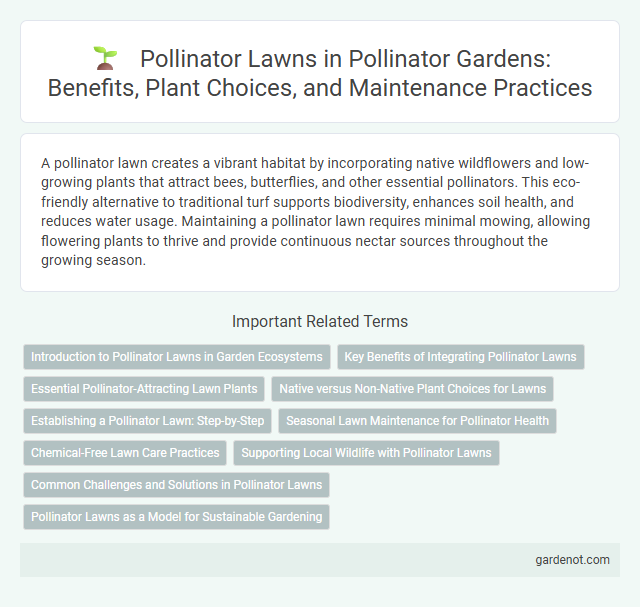A pollinator lawn creates a vibrant habitat by incorporating native wildflowers and low-growing plants that attract bees, butterflies, and other essential pollinators. This eco-friendly alternative to traditional turf supports biodiversity, enhances soil health, and reduces water usage. Maintaining a pollinator lawn requires minimal mowing, allowing flowering plants to thrive and provide continuous nectar sources throughout the growing season.
Introduction to Pollinator Lawns in Garden Ecosystems
Pollinator lawns integrate native grasses and flowering plants that provide essential nectar and pollen sources for bees, butterflies, and other pollinators within garden ecosystems. These eco-friendly lawns enhance biodiversity by supporting beneficial insects, improving soil health, and reducing the need for chemical fertilizers and pesticides. Incorporating pollinator lawns fosters sustainable habitats that contribute to the resilience and productivity of urban and suburban gardens.
Key Benefits of Integrating Pollinator Lawns
Pollinator lawns support biodiversity by providing essential habitats for bees, butterflies, and other pollinators, boosting local ecosystems and enhancing plant reproduction. These lawns reduce the need for chemical fertilizers and pesticides, promoting sustainable landscaping practices and improving soil health. Integrating pollinator lawns also helps conserve water and reduce lawn maintenance costs, contributing to environmental resilience and economic savings.
Essential Pollinator-Attracting Lawn Plants
Essential pollinator-attracting lawn plants include native wildflowers like clover, white yarrow, and self-heal, which provide abundant nectar and pollen for bees, butterflies, and other beneficial insects. Incorporating drought-tolerant grasses such as fine fescues enhances habitat diversity while requiring less water and maintenance. These plants support ecosystem health by promoting pollinator activity, improving soil quality, and increasing biodiversity within residential and urban lawn areas.
Native versus Non-Native Plant Choices for Lawns
Choosing native plants for pollinator lawns enhances local biodiversity by providing essential nectar and habitat suited to native pollinators like bees, butterflies, and hummingbirds. Native grasses and wildflowers have evolved in harmony with regional climates and soil conditions, requiring less maintenance and promoting resilient ecosystems compared to non-native species that may offer limited resources or become invasive. Prioritizing native species supports sustainable lawn management, fosters pollinator health, and contributes to ecological balance.
Establishing a Pollinator Lawn: Step-by-Step
Establishing a pollinator lawn involves selecting native, nectar-rich wildflowers and grasses that support bees, butterflies, and other pollinators while requiring minimal maintenance. Begin by preparing the soil, removing existing turf, and ensuring adequate sunlight and drainage to promote healthy root growth. Regularly monitor the lawn, manage weeds using eco-friendly methods, and avoid pesticides to maintain a thriving habitat for beneficial pollinators.
Seasonal Lawn Maintenance for Pollinator Health
Seasonal lawn maintenance for pollinator health involves tailored mowing schedules that promote wildflowers and native grasses, providing essential forage and habitat throughout the year. Applying organic fertilizers and avoiding pesticides during peak blooming seasons enhance pollinator nutrition and reduce harmful exposure. Regularly removing invasive species supports biodiversity, ensuring a vibrant ecosystem that sustains bees, butterflies, and other vital pollinators.
Chemical-Free Lawn Care Practices
Chemical-free lawn care practices prioritize natural methods such as manual weeding, mulching, and the use of organic fertilizers to sustain a pollinator lawn. Avoiding synthetic pesticides and herbicides enhances pollinator health by reducing chemical exposure that can harm bees, butterflies, and other beneficial insects. Incorporating native flowering plants and maintaining diverse plant species support pollinator populations while promoting a resilient and vibrant ecosystem.
Supporting Local Wildlife with Pollinator Lawns
Pollinator lawns provide essential habitats by incorporating native flowering plants that supply nectar and pollen for bees, butterflies, and other beneficial insects. These lawns enhance biodiversity by supporting local wildlife, including birds and small mammals that rely on pollinators for food. Optimizing soil health and minimizing chemical use in pollinator lawns fosters a sustainable environment, promoting thriving ecosystems within urban and suburban areas.
Common Challenges and Solutions in Pollinator Lawns
Pollinator lawns often face challenges such as invasive weeds, insufficient floral diversity, and mowing practices that disrupt pollinator habitats. Implementing targeted weed control, selecting a mix of native, nectar-rich flowering plants, and adopting reduced or strategic mowing schedules can significantly enhance pollinator presence and lawn sustainability. Soil health improvement through organic amendments also supports robust plant growth and a thriving pollinator ecosystem.
Pollinator Lawns as a Model for Sustainable Gardening
Pollinator lawns integrate native wildflowers and grasses to support essential pollinators like bees and butterflies, enhancing biodiversity and ecosystem resilience. These lawns reduce the need for chemical fertilizers and pesticides, promoting sustainable gardening practices that conserve water and improve soil health. Implementing pollinator lawns contributes significantly to urban green spaces, creating habitats that foster pollinator populations and strengthen local food systems.
Pollinator lawn Infographic

 gardenot.com
gardenot.com